Selected pictures list
1 - 20
Portal:Horses/Selected picture/1

The skeletal system of the horse. The skeletal system has three major functions in the body. It protects vital organs, provides framework, and supports soft parts of the body. Horses typically have 205 bones.
Portal:Horses/Selected picture/2

A Thoroughbred race in Tambo Valley in Australia. Horse racing is an equestrian sport that has been practiced over the centuries; the chariot races of Roman times are an early example. The common sobriquet for Thoroughbred horse racing is "The Sport of Kings".
Portal:Horses/Selected picture/3

Mounted police in Australia. Mounted officers serve in remote areas and in metropolitan areas where their day-to-day function may be picturesque or ceremonial.
Portal:Horses/Selected picture/4
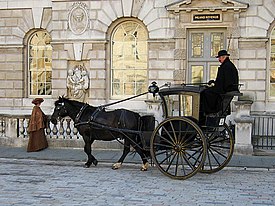
Hansom cab and driver. A hansom cab is a kind of horse-drawn carriage designed and patented in 1834 by Joseph Hansom, an architect from York. Originally known as the Hansom safety cab, its purpose was to combine speed with safety, with a low centre of gravity that was essential for safe cornering.
Portal:Horses/Selected picture/5
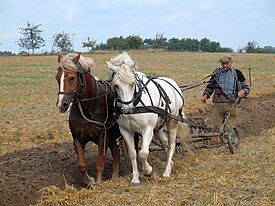
A farmer plowing with horses. The plough (American spelling: plow) is a tool used in farming for initial cultivation of soil in preparation for sowing seed or planting. It has been a basic instrument for most of recorded history, and represents one of the major advances in agriculture.
Portal:Horses/Selected picture/6

A huaso in Chile. A huaso is a Chilean countryman and skilled horseman, similar to the Argentinian or Uruguayan gaucho, the American cowboy, and Mexican vaquero and charro.
Portal:Horses/Selected picture/7

Horses are able to sleep both standing up and lying down. Horses sleep better when in groups because some animals will sleep while others stand guard to watch for predators. A horse kept alone will not sleep well because its instincts are to keep a constant eye out for danger.
Portal:Horses/Selected picture/8

An Icelandic horse near Krýsuvík. The Icelandic horse is a breed of horse developed in Iceland. The breed develops late, but is long-lived and hardy. The Icelandic displays five gaits, rather than the typical three displayed by most other breeds. The breed is popular outside of Iceland, with sizable populations in Europe and North America.
Portal:Horses/Selected picture/9
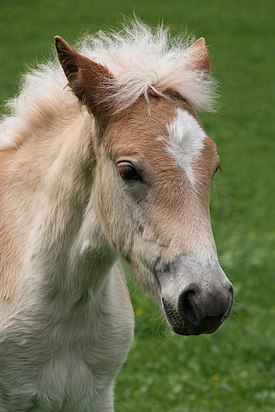
A Haflinger foal. The Haflinger is a breed of horse developed in Austria and northern Italy. Haflinger horses are relatively small and are always chestnut in color. The breed is well-muscled, but with an elegant appearance. Haflingers have many uses, including light draft and harness work as well as various under-saddle disciplines.
Portal:Horses/Selected picture/10

A Thoroughbred race horse at Churchill Downs. The Thoroughbred is a horse breed best known for its use in horse racing. Thoroughbreds are considered a "hot-blooded" horse, known for their agility, speed and spirit, and they have been influential in the creation of many important breeds.
Portal:Horses/Selected picture/11

This Currier & Ives lithograph from 1867 shows harness racing in sleighs in New York during the 19th century.
Portal:Horses/Selected picture/12

A knight in Gothic armor. Europeans used several types of war horses in the Middle Ages, and the best-known heavy cavalry warrior of the period was the armoured knight.
Portal:Horses/Selected picture/13

A 1900 photograph of three Piegan (Blackfeet) Indian chiefs. When Iberian horses were obtained from the Spanish, the Plains tribes rapidly integrated them into their daily lives. By the early 18th century some tribes had fully adopted a horse culture.
Portal:Horses/Selected picture/14

An animated sequence of a horse galloping. The gallop is the fastest gait of the horse and in the wild is used when the animal needs to flee from predators or simply cover short distances quickly.
Portal:Horses/Selected picture/15

Dun horses at Erlebnispark Tripsdrill, Germany
Portal:Horses/Selected picture/16
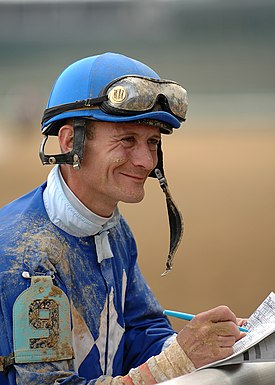
Jockey Calvin Borel after a race at Churchill Downs.
Portal:Horses/Selected picture/17

The Jutland is a breed of draft horse originating in Denmark.
Portal:Horses/Selected picture/18

A shepherd in Kazakhstan, who uses a horse and dogs in his trade.
Portal:Horses/Selected picture/19
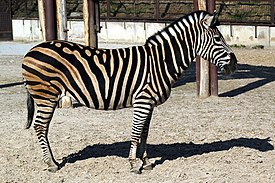
Burchell's Zebra (Equus quagga burchellii) is a southern subspecies of the Plains Zebra.
Portal:Horses/Selected picture/20

Grévy's Zebra, sometimes known as the Imperial Zebra, is the largest species of zebra.
20 - 40
Portal:Horses/Selected picture/21

Chapman's Zebra, a subspecies of the Plains Zebra.
Portal:Horses/Selected picture/22

Anatomy of a horse from a 9th century AH (15th century AD) Egyptian document at the University Library, Istanbul.
Portal:Horses/Selected picture/23

Thoroughbred horse racing in Germany on a turf race course
Portal:Horses/Selected picture/24

A three week old donkey foal. (Equus asinus)
Portal:Horses/Selected picture/25

A female donkey, called a jenny, and her nursing foal. Male donkeys and asses (Equus asinus) used for breeding are called jacks.
Portal:Horses/Selected picture/26

Close-up image of the quadriga (four-horse chariot) on top of the Brandenburg Gate in Berlin, Germany. The sculpture was produced by Johann Gottfried Schadow in 1793.
Portal:Horses/Selected picture/27

The Noriker horse, also historically known as the Pinzgauer horse, is a moderately heavy Austrian draught horse breed. It is considered indigenous to the central Alpine region of Europe, and is believed to have originated around the highest mountain of Austria, the Grossglockner. The Kufenstechenis an event that takes place at Feistritz an der Gail in Carinthia, Austria during the annual Kermesse on Whit Monday. The task of young unmarried men, riding bareback on Noriker horses, is to smash a wooden barrel with an iron. The men have to ride past several times before the barrel is destroyed. Finally, when it is broken, the winner receives a wreath of flowers which he puts on his wrist. Afterwards, the winner begins the traditional dance under the lime tree, joined by other unmarried couples, wearing the traditional Gailtaler folk costumes. The dance is accompanied by traditional songs.
Portal:Horses/Selected picture/28 Portal:Horses/Selected picture/28
Portal:Horses/Selected picture/29 Portal:Horses/Selected picture/29
Portal:Horses/Selected picture/30 Portal:Horses/Selected picture/30